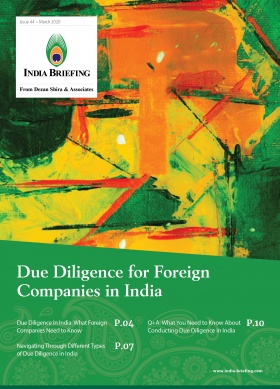Introduction to the Social Security System in India
India’s social security system is composed of a number of schemes and programs spread throughout a variety of laws and regulations. Keep in mind, however, that the government-controlled social security system in India applies to only a small portion of the population.
Furthermore, the social security system in India includes not just an insurance payment of premiums into government funds (like in China), but also lump sum employer obligations.
Generally, India’s social security schemes cover the following types of social insurances:
- Pension;
- Health Insurance and Medical Benefit;
- Disability Benefit;
- Maternity Benefit; and
- Gratuity.
While a great deal of the Indian population is in the unorganized sector and may not have an opportunity to participate in each of these schemes, Indian citizens in the organized sector (which include those employed by foreign investors) and their employers are entitled to coverage under the above schemes.
The applicability of mandatory contributions to social insurances is varied. Some of the social insurances require employer contributions from all companies, some from companies with a minimum of ten or more employees, and some from companies with twenty or more employees.
In this article, we will discuss each of these social insurances, along with their coverage, contribution rates, and the laws and regulations behind them.
The Code on Social Security, 2020
Foreign companies should note that when The Code of Social Security, 2020 – one of the four new labor codes introduced by the Ministry of Labor and Employment – comes into force, it will subsume the following enactments:
- The Employees’ Compensation Act, 1923;
- The Employees’ State Insurance Act, 1948;
- The Employees’ Provident Funds and Miscellaneous Provisions Act, 1952;
- The Employment Exchanges (Compulsory Notification of Vacancies) Act, 1959;
- The Maternity Benefit Act, 1961;
- The Payment of Gratuity Act, 1972;
- The Cine- Workers Welfare Fund Act, 1981;
- The Building and Other Construction Workers Welfare Cess Act, 1996; and
- The Unorganised Workers’ Social Security Act, 2008
Rules for the new labor codes on industrial relations, social security, and occupational safety health & working conditions (OSH) are likely to be finalized by the end of January, according to Labor Secretary Apurva Chandra. If that is the case, it may result in implementation of the labor codes by April 1, 2021 – which was the deadline put by the labor ministry. However, this timeline is subject to change, depending on interventions made by key stakeholders and lobby groups and other exigencies, such as the impact of the ongoing pandemic.
The Labor Secretary was also quoted in the media saying that the draft model standing orders for the manufacturing, mining, and service sectors will be finalized by February. These draft orders set the standards for service conditions and employees’ conduct in the respective sectors and were notified on December 31, 2020 to seek feedback (within a period of 30 days from the date of notification).
Pension or Employees’ Provident Fund
The Employees’ Provident Fund Organization (EPFO), under the Ministry of Labor and Employment, ensures superannuation pension and family pension in case of death during service. Presently, only about 35 million out of a labor force of 400 million have access to formal social security in the form of old-age income protection in India. Out of these 35 million, 26 million workers are members of the Employees’ Provident Fund Organization, which comprises private sector workers, civil servants, military personnel, and employees of State Public Sector Undertakings (PSUs).
The schemes under the EPFO apply to businesses with at least 20 employees. Contributions to the Employees’ Provident Fund (EPF) Scheme are obligatory for both the employer and the employee when the employee is earning up to INR 15,000 (US$205) per month, and voluntary, when the employee earns more than this amount. If the pay of any employee exceeds this amount, the contribution payable by the employer will be limited to the amount payable on the first INR 15,000 only. (US$1=INR 73.14)
For establishments that employ less than 20 employees or meet specific conditions as notified by the EPFO, the contribution rate for both the employee and employer is limited to 10 percent.
Three schemes are supervised by the Employees’ Provident Fund Organization:
- The Employees’ Provident Fund Scheme, 1952;
- The Employees’ Pension Scheme, 1995; and,
- The Employees’ Deposit Linked Insurance Scheme, 1976.
The Employees’ Provident Fund (EPF) Scheme is contributed to by the employer (1.67-3.67 percent) and the employee (10-12 percent). The Employee Pension Scheme (EPS) is contributed to by the employer (8.33 percent) and the government (1.16 percent), but not the employee. Finally, the Employees’ Deposit Linked Insurance (EDLI) Scheme is contributed to by the employer (0.5 percent) only.
Four main types of pension (all monthly) are offered:
- Pension upon superannuation or disability;
- Widows’ pension for death while in service;
- Children’s pension; and,
- Orphan’s pension.
In addition, there are separate pension funds for civil servants, workers employed in coal mines and tea plantations in the state of Assam, and for seamen.
The EPFO allocates a Universal Account Number (UAN) for all employees covered under the Employees’ Provident Funds and Miscellaneous Provisions Act, 1952. The UAN is linked to the employee’s EPF account and will remain portable throughout the lifetime of an employee. This means that there is no need to transfer an EPF account at the time of changing jobs.
An employee can withdraw their provident fund entirely or partially. A complete withdrawal is possible when the employee reaches retirement or is unemployed for longer than two months. In such a situation, the individual must meet specific bureaucratic requirements, such as claim attested by a gazetted officer. A complete withdrawal of the EPF by an individual due to change of jobs – when they have not been unemployed for more than two months – is not permitted. A partial withdrawal of the EPF can be made under certain circumstances, such as for medical purposes, marriage, education, home loan repayment, purchase of land, construction of house, etc. This is subject to certain prescribed conditions, such as the number of years of service of the employee.
Health Insurance and Medical Benefit
India has a national health service, but this does not include free medical care for the whole population. The Employees’ State Insurance (ESI) Act, 1948 created a fund to provide medical care to employees and their families, as well as cash benefits during sickness and maternity, and monthly payments in case of death or disablement for those working in factories and establishments with 10 or more employees. (As on March 31, 2019, the total number of ESI beneficiaries was over 130 million, with coverage extending to over 120,00,000 factories and business establishments.)
Coverage under the ESI scheme has been extended to hotels, shops, cinemas and preview theaters, restaurants, newspaper establishments, and road-motor transport undertakings. The scheme has also been extended to private educational and medical institutions that have employed 10 or more employee. This is applicable in certain states and union territories only.
The ESI scheme offers benefits to both the workers and their dependents in case of any unfortunate eventualities at work. Under the ESI Act, employees or workers employed at the above mentioned categories earning wages up to INR 21,000 per month (up to INR 25,000 per month in case of person with disability) are entitled to this social security scheme.
Eligible workers contribute 0.75 percent of their salary towards the ESI while the employer pays 3.75 percent – making a total contribution of 4.5 percent. These new rates are effective from July 1, 2019. (Earlier these rates stood at 1.75 percent and 4.75 percent, respectively.) The company or establishment can apply for an ESI registration within 15 days from the time the ESI Act becomes applicable to that entity. The Employees’ State Insurance (Central) Amendment Rules, 2017 was notified on January 20, 2017 detailing new maternity benefits for women who have insurance. As of March 31, 2019, 51,20,000 women have benefitted from the scheme.
Further, daily wage earners earning an average wage of up to INR 137 are exempted from payment of contribution. Employers, however, are mandated to contribute their own share in respect of these employees.
Sickness benefit under ESI coverage is 70 percent of the average daily wage and is payable for a maximum of 91 days in a year. To qualify for sickness benefit, the insured worker is required to contribute for 78 days in a contribution period of six months. There are provisions for extended sickness benefits and corresponding eligibility criteria.
ESI also provides disablement benefit, which is applicable from day one of entering insurable employment for temporary disablement benefit. In case of permanent disablement benefit, it is paid at the rate of 90 percent of wage in the form of monthly payment, depending upon the extent of loss of earning capacity as certified by a Medical Board.
Besides sickness and disability pay outs, the ESI provides for dependents’ benefits (DB). The DB paid is at the rate of 90 percent of the wage in the form of monthly payment to the dependents of a deceased insured person – in cases where the death has occurred due to employment injury or occupational hazards.
Other benefits that are offered with ESI are:
- Medical benefits;
- Maternity benefits;
- Unemployment allowance;
- Confinement expenses;
- Funeral expenses;
- Physical rehabilitation;
- Vocational training; and
- Skill upgradation training under Rajiv Gandhi Shramik Kalyan Yojana (RGSKY).
A one-time relaxation has been extended to employers who could not file the return of ESI contribution for the contribution period from April 1, 2020 to September 30, 2020 due to the extenuating circumstances faced by enterprises last year. The new deadline to file this return is January 15, 2021. This does not impact employees contributing to and receiving benefits from the ESI. Also, no further relaxations have been provided for older or newer contribution periods.
Disability Benefit
The Employee’s Compensation Act, 1923, formerly known as the ‘Workmen’s Compensation Act, 1923’, requires the employer to pay compensation to employees or their families in cases of employment related injuries that result in death or disability.
In addition, workers employed in certain types of occupations are exposed to the risk of contracting certain diseases, which are peculiar and inherent to those occupations. A worker contracting an occupational disease is deemed to have suffered an accident out of and in the course of employment, and the employer is liable to pay compensation for the same. Injuries resulting in permanent total and partial disablement are listed in parts I and II of Schedule I of the Employee’s Compensation Act, while occupational diseases have been defined in parts A, B, and C of Schedule III of the Employee’s Compensation Act.
Last year, the central government changed the wage amount to be considered for calculation of compensation to workers under the Employee’s Compensation Act, 1923 vide notification S.O.71 (E) dated January 3, 2020. Now, it will be INR 15,000 (US$205), according to the notification by the Ministry of Labor and Employment. The previous wage amount considered for the calculation of compensation was just INR 8,000 (US$109).
Compensation calculation depends on the situation of occupational disability:
(a) Death
50 percent of the monthly wage multiplied by the relevant factor or an amount of INR 120,000 (US$1,640), whichever is more.
(b) Total permanent disablement
60 percent of the monthly wage multiplied by the relevant factor or an amount of INR 120,000 (US$1,640), whichever is more.
The relevant factor for computation is mentioned in Schedule IV of the Employee’s Compensation Act.
Maternity Benefit
The Maternity Benefit (Amendment) Act, 2017 came into force on April 1, 2017, and increases some of the key benefits mandated under the previous Maternity Benefit Act of 1961. The amended law provides women in the organized sector with paid maternity leave of 26 weeks, up from 12 weeks, for the first two children. For the third child, the maternity leave entitled will be 12 weeks. India now has the third most maternity leave in the world, following Canada (50 weeks) and Norway (44 weeks).
The Act also secures 12 weeks of maternity leave for mothers adopting a child below the age of three months as well as to commissioning mothers (biological mothers) who opt for surrogacy. The 12-week period in these cases will be calculated from the date the child is handed over to the adoptive or commissioning mother.
In other provisions, the law mandates that every establishment with over 50 employees must provide crèche facilities within easy distance, which the mother can visit up to four times a day. For compliance purposes, companies should note that this particular provision will come into effect from July 1, 2017.
The Maternity Benefit (Amendment) Act introduces the option for women to negotiate work-from-home, if they reach an understanding with their employers, after the maternity leave ends.
Under the pre-existing Maternity Benefit Act of 1961, every woman is entitled to, and her employer is liable for, the payment of maternity benefit at the rate of the average daily wage for the period of the employee’s actual absence from work. Apart from 12 weeks of salary, a female worker is entitled to a medical bonus of INR 3,500 (US$47.85).
The 1961 Act states that in the event of miscarriage or medical termination of pregnancy, the employee is entitled to six weeks of paid maternity leave. Employees are also entitled to an additional month of paid leave in case of complications arising due to pregnancy, delivery, premature birth, miscarriage, medical termination, or a tubectomy operation (two weeks in this case).
In addition to the above, the 1961 Act states that no company shall compel its female employees to do tasks of a laborious nature or tasks that involve long hours of standing or which in any way are likely to interfere with her pregnancy or the normal development of the fetus, or are likely to cause her miscarriage or otherwise adversely affect her health.
Changes expected under The Code on Social Security, 2020
- Inspector cum facilitators will be hired for the purpose of ensuring the rules of the Act are being upheld. They will be able to get information from employers about their female employees, regarding the kind of work they do and the wages they are paid, as well as enquire about any complaints they may have.
- Inspector cum facilitators will allow offending employers a period of time to begin complying with the rules of the Act by way of a written statement. If they do so, no action will be taken against them.
- It will be ensured that female employees who work in the unorganized sector are able to establish their identities via their Aadhaar number.
- Employers who withhold maternity rights from their female employees will be fined INR 50,000 (approx. US$683) or be imprisoned for at least six months or both.
- If a female employee is denied maternity rights and she is part of a trade union under the Trade Unions Act of 1926, she is eligible to file a complaint with them that will be heard in any court of competent jurisdiction. However, only the denied employee and the inspector cum facilitator can approach the court for help.
Gratuity
The Payment of Gratuity Act, 1972 directs establishments with 10 or more employees to provide the payment of 15 days of additional wages for each year of service to employees who have worked at a company for five years or more.
Gratuity is provided as a lump sum payout by a company. In the event of the death or disablement of the employee, the gratuity must still be paid to the nominee or the heir of the employee.
The employer can, however, reject the payment of gratuity to an employee if the individual has been terminated from the job due to any misconduct. In such a case of forfeiture, there must be a termination order containing the charges and the misconduct of the employee.
Gratuity is calculated through the formula mentioned below:
Gratuity = Last Drawn Salary × 15/26 × Tenure of Service, where:
- The ratio 15/26 represents 15 days out of 26 working days in a month.
- Last Drawn Salary = Basic Salary + Dearness Allowance.
- Tenure of Service is rounded up or down to the nearest full year. For example, if the employee has a total service of 10 years, 10 months and 25 days, 11 years will be factored into the calculation.
Gratuity is exempt from taxation provided that the amount does not exceed 15 days’ salary for every completed year of service calculated on the last drawn salary (subject to a maximum of INR 2 million). It is important to note that an employer can choose to pay more gratuity to an employee, which is known as ex-gratia and is a voluntary contribution. Ex-gratia is subject to tax.
(Editor’s Note: The article was first published in March 2013. It was last updated on May 6, 2022.)
About Us
India Briefing is produced by Dezan Shira & Associates. The firm assists foreign investors throughout Asia from offices across the world, including in Delhi and Mumbai. Readers may write to india@dezshira.com for business support in India.
- Previous Article India’s Corporate Compliance Calendar for FY2022-23: Mandatory Forms and Due Dates
- Next Article Calculating Income Tax for Foreign Nationals in India








